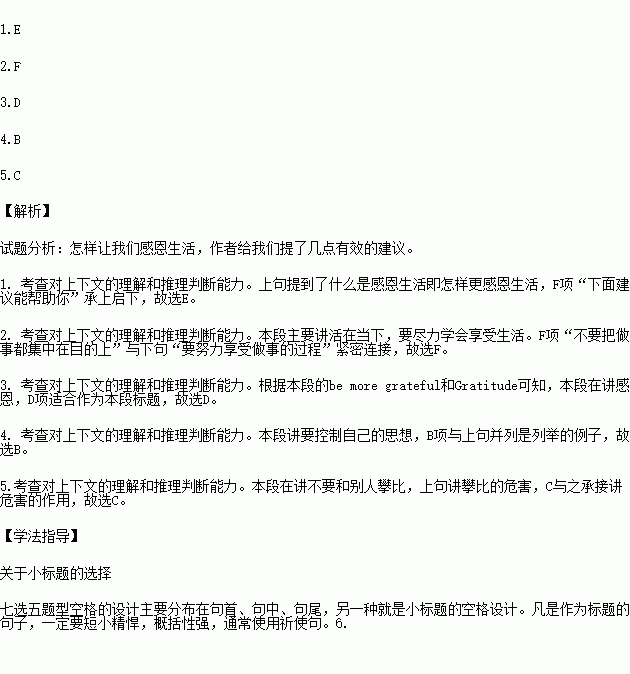题目内容
根据短文内容,从短文后的选项中选出能填入空白处的最佳选项。选项中有两项为多余选项。
To be more grateful in life means that you are also allowing yourself to be happier, more contented and more satisfied with everything that has been going on around you. But with all the stress, all the disappointments and all the anxiety around you, I bet you ask yourself this question all the time:“How exactly can I be more grateful with my life?” 1. .
1. Learn to live in the moment.
life is a wonderful adventure full of enriching experiences and endless possibilities. Don’t just go through the motions of repetitive activities and boring tasks. No! Being a mindless zombie can make you more likely to take things for granted. 2. , make an effort to enjoy the experience.
You’re supposed to attend a conference? Absorb it. Babysit your niece? Enjoy the moment. Eat a 15-minute lunch? Taste each bite.
2. 3.
Being aware of your goal to be more grateful can help you look for things to be really more grateful for. Gratitude is a conscious decision. You have to practice it consistently.
3. Control your thoughts.
Of course you have the power to control what you're. To be more grateful in life means that you are thinking of! Consider this exercise, for example:if you find yourself thinking more and more self-entitled, stop. __ 4._ . You are given consciousness. Make use of it wisely.
4. Always resist the temptation of comparing yourself with other people.
As humans, we have the natural tendency to compare ourselves with others with the hope of attaining satisfaction. Actually, this kind of activity does not help you feel to be more grateful in life. 5. ! You will always be meeting someone richer, which makes you feel inferior to others!
Don' t do it, please.
Every little thing counts. You have the ability to make yourself feel to be more grateful in your life.
A. Appreciate what you have right now
B. And if you find yourself repeating negative junk, stop
C. It does the opposite
D. Express gratitude all the time
E. Well, the following are some tips to help you with this particular concern
F. Instead of doing something just for the sake of doing it
G. Words that stress you and make you feel worthless should definitely be removed
 名校课堂系列答案
名校课堂系列答案
